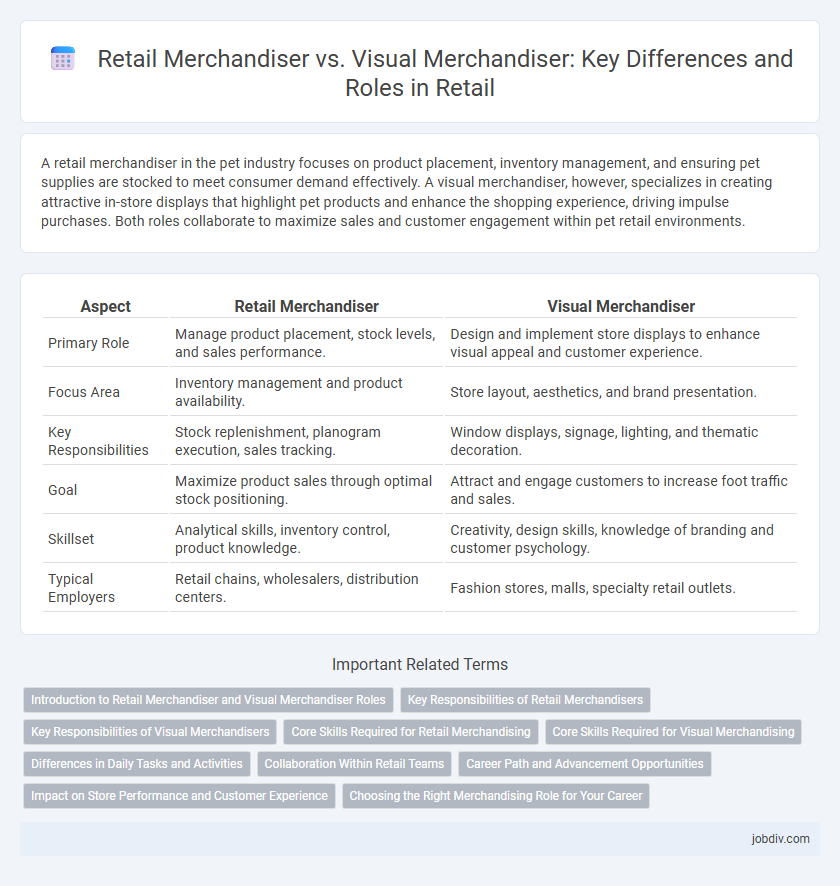A retail merchandiser in the pet industry focuses on product placement, inventory management, and ensuring pet supplies are stocked to meet consumer demand effectively. A visual merchandiser, however, specializes in creating attractive in-store displays that highlight pet products and enhance the shopping experience, driving impulse purchases. Both roles collaborate to maximize sales and customer engagement within pet retail environments.
Table of Comparison
| Aspect | Retail Merchandiser | Visual Merchandiser |
|---|---|---|
| Primary Role | Manage product placement, stock levels, and sales performance. | Design and implement store displays to enhance visual appeal and customer experience. |
| Focus Area | Inventory management and product availability. | Store layout, aesthetics, and brand presentation. |
| Key Responsibilities | Stock replenishment, planogram execution, sales tracking. | Window displays, signage, lighting, and thematic decoration. |
| Goal | Maximize product sales through optimal stock positioning. | Attract and engage customers to increase foot traffic and sales. |
| Skillset | Analytical skills, inventory control, product knowledge. | Creativity, design skills, knowledge of branding and customer psychology. |
| Typical Employers | Retail chains, wholesalers, distribution centers. | Fashion stores, malls, specialty retail outlets. |
Introduction to Retail Merchandiser and Visual Merchandiser Roles
Retail merchandisers optimize product placement and inventory levels to maximize sales and enhance customer buying experiences through data-driven strategies. Visual merchandisers design store layouts, displays, and signage to attract customers and create appealing shopping environments that reflect brand identity. Both roles collaborate closely to boost retail performance by combining effective stock management with engaging visual presentation.
Key Responsibilities of Retail Merchandisers
Retail Merchandisers focus on inventory management, product placement, and sales analysis to ensure optimal stock levels and maximize revenue. They coordinate with suppliers, monitor competitor pricing, and implement promotional strategies to boost product visibility and turnover. Their role emphasizes logistical efficiency and data-driven decisions to enhance overall retail performance.
Key Responsibilities of Visual Merchandisers
Visual Merchandisers design retail store layouts and product displays to enhance customer engagement and drive sales performance. They analyze shopper behavior and collaborate with marketing teams to create visually appealing themes that reflect brand identity. Responsibilities include planning window displays, optimizing in-store signage, and ensuring consistent brand presentation across all retail locations.
Core Skills Required for Retail Merchandising
Retail merchandisers require strong analytical skills, inventory management expertise, and proficiency in sales forecasting to optimize product placement and maximize profitability. Expertise in market trend analysis and supplier negotiation ensures effective stock replenishment and pricing strategies. Additionally, attention to detail and excellent communication skills facilitate seamless coordination between suppliers, store staff, and marketing teams.
Core Skills Required for Visual Merchandising
Visual merchandising requires expertise in spatial awareness, color theory, and consumer psychology to create appealing store layouts that drive sales. Proficiency in graphic design tools and a keen eye for trends enable visual merchandisers to develop innovative displays that enhance brand identity. Strong communication and collaboration skills are essential to coordinate with retail merchandisers, marketing teams, and store staff to implement cohesive merchandising strategies.
Differences in Daily Tasks and Activities
Retail merchandisers focus on product placement, inventory management, and ensuring stock availability to maximize sales efficiency. Visual merchandisers specialize in creating attractive displays, designing store layouts, and enhancing brand aesthetics to improve customer experience. Both roles collaborate to drive retail performance but differ in operational versus creative daily activities.
Collaboration Within Retail Teams
Retail merchandisers and visual merchandisers collaborate closely to optimize store performance by aligning product placement with aesthetic appeal. Retail merchandisers analyze sales data to plan inventory and product displays, while visual merchandisers design layouts that enhance customer experience and drive foot traffic. Effective teamwork between these roles ensures cohesive presentation, maximizes sales opportunities, and strengthens overall brand identity within retail environments.
Career Path and Advancement Opportunities
Retail Merchandisers focus on product placement and inventory planning to maximize sales, often advancing into roles such as Category Manager or Supply Chain Analyst through experience in market analysis and vendor relations. Visual Merchandisers specialize in store aesthetics and customer experience by designing appealing displays to drive foot traffic, with career progression leading to positions like Visual Director or Brand Experience Manager. Both paths offer growth opportunities in retail management but emphasize distinct skill sets in operational strategy versus creative presentation.
Impact on Store Performance and Customer Experience
Retail merchandisers optimize product assortment and inventory levels to maximize sales and reduce stockouts, directly impacting store profitability and operational efficiency. Visual merchandisers design the store layout and displays to enhance aesthetic appeal and guide customer flow, significantly influencing shopper engagement and purchase decisions. Both roles collaboratively elevate customer experience and store performance by balancing product availability with compelling in-store presentation.
Choosing the Right Merchandising Role for Your Career
Choosing the right merchandising role depends on your strengths and career goals within retail; retail merchandisers focus on inventory management, sales analysis, and product placement to maximize profitability. Visual merchandisers specialize in creating appealing store displays and layouts to enhance customer experience and brand perception. Understanding these distinct responsibilities helps align your skills with the most suitable merchandising career path.
Retail Merchandiser vs Visual Merchandiser Infographic

 jobdiv.com
jobdiv.com